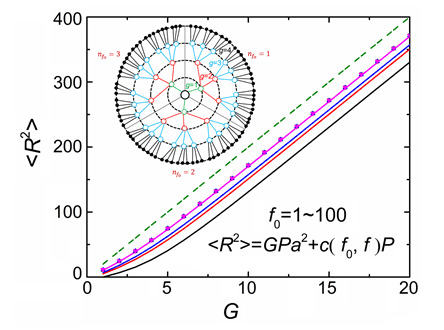| [1] Xia, K.; Sheng, R.; Zhu, Y.; Li, H.; Luo, T.; Xu, Y.; Cao, A. Acta Chim. Sinica 2010, 68, 1130(in Chinese). (夏可嘉, 盛瑞隆, 朱英丹, 李慧, 罗挺, 徐宇虹, 曹阿民, 化学学报, 2010, 68, 1130.)
[2] Li, J.; Zeng, Y.; Zhang, X.; Yu, T.; Chen, J.; Li, Y. Acta Chim. Sinica 2014, 72, 1157(in Chinese). (李婧, 曾毅, 张小辉, 于天君, 陈金平, 李嫕, 化学学报, 2014, 72, 1157.)
[3] Qin, T.; Zeng, Y.; Chen, J.; Yu, T.; Li, Y. Acta Chim. Sinica. 2017, 75, 99(in Chinese). (秦天依, 曾毅, 陈金平, 于天君, 李嫕, 化学学报, 2017, 55, 99.)
[4] Adachi, N.; Sugiyama, H.; Arai, M.; Ogawa, H. Molecules 2014, 19, 4135.
[5] Shaw, P. E.; Cavaye, H.; Chen, S. S. Y.; James, M.; Gentle, I. R.; Burn, P. L. Phys. Chem. Chem. Phys. 2013, 15, 9845.
[6] Rahman, M. A.; Noh, H. B.; Shim, Y. B. Anal. Chem. 2008, 80, 8020
[7] Peng, X. H.; Pan, Q. M.; Rempel, G. L. Chem. Soc. Rev. 2008, 37, 1619.
[8] Yoon, H. C.; Hong, M. Y.; Kim, H. S. Anal. Chem. 2000, 72, 4420.
[9] Bielinska, A. U.; Yen, A.; Wu, H. L.; Zahos, K. M.; Sun, R.; Weiner, N. D.; Baker, J. R.; Roessler, B. J. Biomaterials 2000, 21, 877.
[10] Vincent, L.; Varet, J.; Pille, J.-Y.; Bompais, H.; Opolon, P.; Maksimenko, A.; Malvy, C.; Mirshahi, M.; Lu, H.; Vannier, J.-P.; Soria, C.; Li, H. Int. J. Cancer 2003, 105, 419.
[11] Jain, S.; Kaur, A.; Puri, R.; Utreja, P.; Jain, A.; Bhide, M.; Ratnam, R.; Singh, V.; Patil, A. S.; Jayaraman, N.; Kaushik, G.; Yadav, S.; Khanduja, K. L. Eur. J. Med. Chem. 2010, 45, 4997.
[12] Kesharwani, P.; Jain, K.; Jain, K. N. Prog. Polym. Sci. 2014, 39, 268.
[13] Astruc, D.; Boisselier, E.; Ornelas, C. Chem. Rev. 2010, 110, 1857.
[14] Buhleier, G. E.; Wehner, W.; Vögtle, F. Chemischer Informationsdienst 1978, 2, 155.
[15] Cloninger, M. J. Curr. Opin. Chem. Biol. 2002, 6, 742.
[16] de Gennes, P. G.; Hervet, H. Journal de Physique-Lettres 1983, 44, L351.
[17] Lescanec, R. L.; Muthukumar, M. Macromolecules 1990, 23, 2280.
[18] Mansfield, M. L.; Klushin, L. I.; Klushint, L. I. Macromolecules 1993, 26, 4262.
[19] Biswas, P.; Cherayilk, B. J.; Klushint, L. I. J. Chem. Phys. 1993, 26, 4262.
[20] Chen, Z. Y.; Cui, S.-M. Macromolecules 1996, 29, 7943.
[21] Carl, M. J. Chem. Soc. 1996, 92, 4151.
[22] Carbone, P.; Müller-Plathe, F. Soft Matter 2009, 5, 2638.
[23] Jurjiu, A.; Dockhorn, N.; Mironova, O.; Sommer, J.-U. Soft Matter 2014, 10, 4935.
[24] Freire, J. J.; Rubio, A. M. Polymer 2008, 49, 2762.
[25] Boris, D.; Rubinstein, M. Macromolecules 1996, 29, 7251.
[26] Götze, I. O.; Likos, C. N. Macromolecules 2003, 36, 8189.
[27] Lyulin, A. V.; Davies, G. R.; Adolf, D. B. Macromolecules 2000, 33, 6899.
[28] Sheng, Y. J.; Jiang, S. Y.; Tsao, H. K. Macromolecules 2002, 35, 7865.
[29] Kumar, A.; Biswas, P. J. Chem. Phys. 2011, 134, 214901.
[30] Kumar, A.; Biswas, P. Macromolecules 2010, 43, 7378.
[31] Cui, W.; Su, C. F.; Merlitz, H.; Wu, C. X.; Sommer, J. U. Macromolecules 2014, 47, 3645.
[32] Bosko, J. T.; Prakash, J. R. Macromolecules 2011, 44, 660.
[33] Rubio, A. M.; McBride, C.; Freire, J. J. Macromolecules 2014, 47, 5379.
[34] Mandal, T.; Dasgupta, C.; Maiti, P. K. J. Chem. Phys. 2014, 141, 144901.
[35] Lu, Y.; An, L.; Wang, Z. G. Macromolecules 2013, 46, 5731.
[36] Jana, C.; Jayamurugan, G.; Ganapathy, R.; Maiti, P. K.; Jayaraman, N.; Sood, A. K. J. Chem. Phys. 2006, 124, 204719.
[37] Porcar, L.; Hong, K.; Butler, P. D.; Herwig, K. W.; Smith, G. S.; Liu, Y.; Chen, W. R. J. Phys. Chem. B 2010, 114, 1751.
[38] Prosa, T. J.; Bauer, B. J.; Amis, E. J. Macromolecules 2001, 34, 4897.
[39] Pötschke, D.; Ballauf, M.; Lindner, P.; Fischer, M.; Vögtle, F. J. Appl. Crystallogr. 2000, 33, 605.
[40] Rosenfeldt, S.; Dingenouts, N.; Ballauf, M.; Werner, N.; Vögtle, F.; Lindner, P. Macromolecules 2002, 35, 8098.
[41] Prosa, T. J.; Bauer, B. J.; Amis, E. J.; Tomalia, D. A.; Scherrenberg, R. J. Polym. Sci. Part B Polym. Phys. 1997, 35, 2913.
[42] Rathgeber, S.; Monkenbusch, M.; Kreitschmann, M.; Urban, V.; Brulet, A. J. Chem. Phys. 2002, 117, 4047.
[43] Caminade, A. M.; Laurent, R.; Majoral, J. P. Adv. Drug Deliver. Rev. 2005, 57, 2130.
[44] Tanaka, H.; Koizumi, S.; Hashimoto, T.; Iyoh, H.; Satoh, M.; Naka, K.; Chujo, Y. Macromolecules 2007, 40, 4327.
[45] Klos, J. S.; Sommer, J. U. Macromolecules 2013, 46, 3107.
[46] Shi, M.; Yang, Y. Z.; Qiu, F. Acta Chim. Sinica 2018, 76, 715(in Chinese). (石梦, 杨颖梓, 邱枫, 化学学报, 2018, 76, 715)
[47] Mallamace, F.; Canetta, E.; Lombardo, D.; Mazzaglia, A.; Romeo, A.; Scolaro, L. M.; Maino, G. Physica A 2002, 304, 235.
[48] Yang, Y. Z.; Qiu, F.; Zhang, H. D.; Yang, Y. L. Macromolecules 2017, 50, 4007.
[49] Yang, Y. L.; Qiu, F.; Tang, P.; Zhang, H. D. Sci. China Chem. 2006, 36, 1(in Chinese). (杨玉良, 邱枫, 唐萍, 张红东, 中国科学B辑化学, 2006, 36, 1.) |
